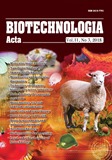ISSN 2410-7751 (Print)
ISSN 2410-776X (Online)

"Biotechnologia Acta" V. 11, No 3, 2018
https://doi.org/10.15407/biotech11.03.047
Р. 47-55, Bibliography 27, English
Universal Decimal Classification: 631.81.033:574
APPLICATION OF BIOFILMS IN REMOVAL OF HEAVY METALS FROM WASTEWATER IN STATIC CONDITION
Ogbuagu Dike Henry 1, Nwachukwu Ikenna Ndubuisi 2, Ejike Onyinye Joy 1
1 Department of Environmental Technology, Federal University of Technology, Owerri, Nigeria
2 Department of Microbiology, Federal University of Technology, Owerri, Nigeria
The aim of the research was to utilize biofilms as a model in ecotoxicology to remove selected heavy metals (Cd, Cu, Cr, Zn and Pb) from wastewater in a static condition. Biofilms were grown in three graded concentrations of the metal leachates (0.625, 0.417 and 0.250 %), harvested after 1, 2 and 3 weeks and analyzed for heavy metals. Mean accumulations peaked on Day 21, and of Cd ranged from 0.000 to 0.040 (mean = 0.00837 ± 0.002), Cu from 0.000 to 0.212 (meam = 0.03929 ± 0.012), Cr from 0.000 to 0.500 (mean = 0.05821 ± 0.021), Zn from 0.000 to 1.456 (mean = 0.31833 ± 0.109) and Pb from 0.000 to 0.099 (mean = 0.02129 ± 0.006) mg/g in resultant biofilm formations. Accumulation of the metals increased significantly with time [F(205.59) > Fcrit(3.95)] at the 95% confidence interval. Those of Pb was significantly higher in the 0.625% leachate mixture than control (Sig F = 0.034) at P < 0.05, even as those of Cd and Cu were slightly higher in the concentrations than control. Biofilm model removed small amounts of metals from wastewater stream in static condition.
Key words: heavy metals, biofilms, bioaccumulation, wastewater, static condition.
© Palladin Institute of Biochemistry of National Academy of Sciences of Ukraine, 2018
References
1. Costa A. D., Carlis A., Pereira F. Bioaccumulation of copper, zinc, cadmium and lead by Bacillus Spp., Bacillus cereus, Bacillus sphaericus and Bacillus subtilis. Braz. J. Microbiol. 2006, 32 (1), 1–5. https://doi.org/10.1590/S1517-83822001000100001
2. Barakat M. A. New Trends in Removing Heavy Metals from Industrial Waste water. Arab. J. Chem. 2011, 4, 361–377. https://doi.org/10.1016/j.arabjc.2010.07.019
3. Ogbuagu D. H., Okoli C. G., Emereibeole E. I., Anyanwu I. C., Onuoha O., Ubah N. O., Ndugbu C. O., Okoroama O. N., Okafor A., Ewa E., Ossai R., Ukah F. Trace metals accumulation in biofilms of the upper and middle reaches of Otamiri River in Owerri, Nigeria. J. Biodiver. Environm. Sci. (JBES). 2011, 1 (3), 19–26.
4. Babel S., Kurniawan T. A. Low-cost absorbent for heavy metals uptake from contaminated water: a review. J. Hazard. Mater. 2003, 97 (1), 219–243. https://doi.org/10.1016/S0304-3894(02)00263-7
5. Perpetuo E. A. Engineering bacteria for bioremediation. In carpi A. (Ed.) Progress in molecular and environmental Bioengineering from analysis and modeling to technology application. Rijika: Intech. 2011, 605–632.
6. Mansour S. A., Sidky M. M. Ecotoxicological studies: heavy metals contaminating water and fish from Fayum Governorate, Egypt. Food Chem. 2002, 78 (1), 15–22. https://doi.org/10.1016/S0308-8146(01)00197-2
7. Fomina M., Gadd G. M. Biosorption: current perspectives on concept, definition and application. Bioresource Technol. 2014, 160, 3–14. https://doi.org/10.1016/j.biortech.2013.12.102
8. Volesky B., Holan Z. K. Biosorption of heavy metals. Biotechnol. Progr. 1995, 11 (3), 235–250. https://doi.org/10.1021/bp00033a001
9. Eccles H. Treatment of metal contamination waste. Why select a biological process? Trends Biotechnol. 1999, 17, 462–465. https://doi.org/10.1016/S0167-7799(99)01381-5
10. Srivastava S., Agrawal S., Mondal M. A review on progress of heavy metal removal using adsorption of microbial and plant origin. Environm. Sci. Pollut. Res. 2013, 22 (20), 15386–15415. https://doi.org/10.1007/511356-5278-9PMID26313592.
11. Costerton J. W., Lewandowski Z., De Beer D., Caldwell D., Korber D., Jamese G. Minireview: biofilms, the customized microniche. J. Bacteriol. 1994, 176, 2137–2142. https://doi.org/10.1128/jb.176.8.2137-2142.1994
12. Wimpenny J. Heterogeneity in biofilms. FEMS Microbial Rev. 2000, 24, 661–667. https://doi.org/10.1111/j.1574-6976.2000.tb00565.x
13. Deibel V., Schoeni J. Biofilms: Forming a defense strategy for the food plant. Food Safety Magazine, De. 2003, 2002/Jan. 2003 edition.
14. Sutherland I. W. The biofilm matrixan immobilized but dynamic microbial environment. Trend Microbial. 2001, 9, 222–227. https://doi.org/10.1016/S0966-842X(01)02012-1
15. Flemming H-C., Nue T. R.,Wozniak D. J. The EPS matrix: the “house of biofilm cell”. J. Bacteriol. 2007, 189 (22), 7945–7947. https://doi.org/10.1128/JB.00858-07
16. Gupta V. K., Nayak A., Aganoval S. Biosorbents for remediation of heavy metals: current status and their future prospects. Environm. Engineer. Res. 2015, 20 (1), 1–18.
17. Meylan S., Sigg L., Behra R. Metal accumulation in algal biofilms. Eawag: Swiss Federal Institute of Aquatic Science and Technology. 2006, 60e, 19–21.
18. Aryal M. Removal and recovery of Nickel ions from Aqueous solution using bacillus Sphaericcus Biomass. Int. J. Environm. Res. 2015, 9 (4), 1147–1156.
19. IIyina A., Castillo S. M. I., Villarreal S. J. A., Ramirez E. G., Candelas R. J. Isolation of soil bacteria for bioremediation of hydrocarbon contamination. Vestnik Mosk. un-ta. Ser. 2. Khimiya. 2003, 44 (1).
20. Zhang W. Removal of hexavalent chromium from waste water using magmetotactic bacteria. Separ. Purific. Technol. 2014, 136, 10–17. https://doi.org/10.1016/j.seppur.2014.07.054
21. Chipasa K. B. Accumulation and fate of selected heavy metals in a biological waste water treatment system. Waste Management. 2003, 23 (2), 135–143. PMID: 12623088. https://doi.org/10.1016/S0956-053X(02)00065-X
22. Karvalas M., Katsogiannis A., Samara C. Occurrence and fate of heavy metals in the waste water treatment process. Chemosphere. 2003, 53 (10), 120–10. PMID: 14550351.
23. Doering M., Uehlinger U. Biofilms in the Tagliamento. Eawag: Swiss Fed. Inst. Aquatic Sci. Technol. 2006, 60e, 11–13.
24. Azizi S., Valipour A., Sithebe T. Evaluation of different waste water treatment processes and development of a Modified Attached Growth Bioreactor as a decentralized approach for small communities. Sci. Word J. 2013, 1–8. Article ID 156870. https://doi.org/10.1155/2013/156870
25. United Nations Environmental Programme Global Environment Monitoring System (UNEP GEMS)/Water Programme. Water quality for ecosystem and human health. UNEP-GEM System/Water Programme, Burlington, Ontario. 2006, 132 p.
26. Huang Y., Zhang D., Xu Z., Yuan S., Li Y., Wang L. Effect of overlying water pH, dissolved oxygen and temperature on heavy metal release from river sediments under laboratory conditions. Arch. Environm. Protect. 2017, 43 (2), 28–36. https://doi.org/10.1515/aep-2017-0014
27. Piccirillo C., Pereira S. Bacteria immobilization on hydroxyapatite surface for heavy metals. J. Environm. Manag. 2013, 121, 187–195. https://doi.org/10.1016/j.jenvman.2013.02.036.

